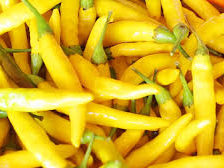While “Peperoncino” is the all encompassing Italian name for chili peppers, referring to the species Capsicum annuum and C. frutescens. The sweet pepper is “peperoni (plural) not to be confused with what we Americans eat on pizza, so if you are ordering pizza in Italy ofr Switzerland don’t be depressed if you get this chili on your pizza instead of the spiced salami, but I digress. This pepper is one fantastic delight to the palate! You will find it as a condiment soaking in a jar of oil at most good Italian restaurants in Italy and Switzerland and are used for adding flare to your pizza or pasta. They have an intense sweetness similar to the red bell pepper but carry a spicy punch similar to a jalapeño, making for an interesting addition to your salads, marinades or curry.
Historically the peperoncino was likely brought to Italy via Spain as a result of Christopher Columbus samples brought back from the Americas to Spain in similar fashion to the tomato (16th century), Both the tomato and Pepper were used as ornamental plants and believed to be poisonous until they gradually worked their way into the Italian cuisine. The earliest recorded use goes back to 1568 a recipe from 1694 the Italian cook by Antonio Latini where he used the peperoncino in a recipe for “salsa alla Spagnola”, consisting of tomatoes, peperoncini, onion, peppermint, salt, and oil and used as a sort of relish or chutney. He even compared it with similar sized peppers from Asia and described them as being significantly spicier.
Our seeds were sourced in Switzerland from the local market and came in both red and yellow, both of which are offered at our sale. The red fruits tend to be sweeter than the yellow and the yellow tend to be a bit more consistent with the hot spicy notes. I love both varieties and especially love them in my cucumber and tomato salads drenched in apple balsamic, olive oil, and salt with fresh herbs like basil and cilantro. these are all around perfect additions to every dish!
More plants?Come to the Garden of Eat’n and discover our 2021 varieties.
